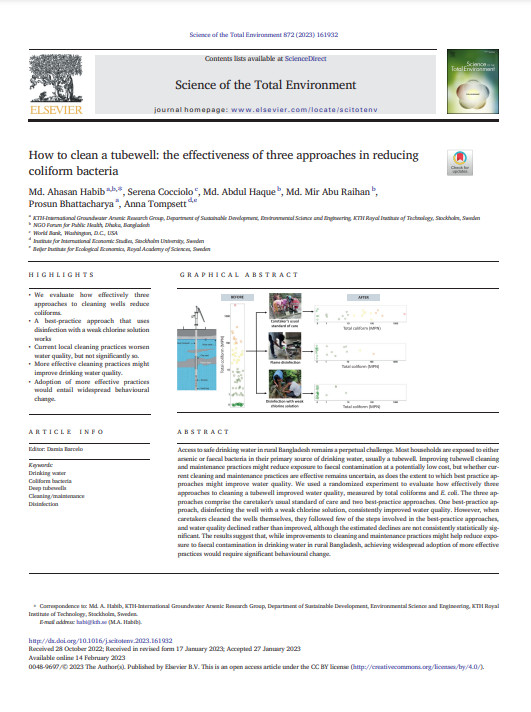How to clean a tubewell: the effectiveness of three approaches in reducing coliform bacteria
 |
article May 2023 ; 9 pages
Ed. Elsevier -
Téléchargeable sous format: PdF
Téléchargeable chez l'éditeur
Page de présentation d'un éditeur
Abstract:
Access to safe drinking water in rural Bangladesh remains a perpetual challenge. Most households are exposed to either arsenic or faecal bacteria in their primary source of drinking water, usually a tubewell. Improving tubewell cleaning and maintenance practices might reduce exposure to faecal contamination at a potentially low cost, but whether current cleaning and maintenance practices are effective remains uncertain, as does the extent to which best practice approaches might improve water quality. We used a randomized experiment to evaluate how effectively three approaches to cleaning a tubewell improved water quality, measured by total coliforms and E. coli. The three approaches comprise the caretaker's usual standard of care and two best-practice approaches. One best-practice approach, disinfecting the well with a weak chlorine solution, consistently improved water quality. However, when caretakers cleaned the wells themselves, they followed few of the steps involved in the best-practice approaches, and water quality declined rather than improved, although the estimated declines are not consistently statistically significant. The results suggest that, while improvements to cleaning and maintenance practices might help reduce exposure to faecal contamination in drinking water in rural Bangladesh, achieving widespread adoption of more effective practices would require significant behavioural change.
Mots clefs: |
forage (CI) (DT) (OP) (ope) , pompe (CI) (DT) (OP) (ope) , potabilisation (CI) (DT) (OP) (ope) |
Editeur/Diffuseur: |
|
Elsevier - |
En cas de lien brisé, nous le mentionner à communication@pseau.org